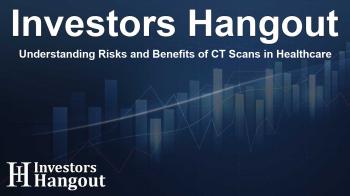Understanding Risks and Benefits of CT Scans in Healthcare

Understanding the Radiation Risks of CT Scans
Recent studies have stirred discussions about the radiation risks associated with CT scans, reflecting concerns about long-term health effects. While theoretical risks may appear significant, they often stem from statistical models rather than concrete patient outcomes. It's crucial to recognize that the safety protocols and advancements in technology have played a vital role in reducing the overall radiation exposure patients receive.
Seeking Balance: Risks versus Benefits
Amidst the ongoing dialogue regarding radiation exposure, it's essential to emphasize that medical imaging, especially CT scans, are critical in modern healthcare. Studies indicate that increased utilization of such imaging techniques correlates with lower cancer mortality rates, as these tools assist in early diagnosis and treatment, ultimately saving lives.
The Role of Technology in Patient Safety
Technological advancements and improved imaging protocols significantly contribute to minimizing radiation exposure during scans. Continuous improvements ensure that imaging technology is not only effective but also responsible. Patients can discuss these benefits and risks with healthcare providers, ensuring informed decisions about their medical care.
Importance of Consulting Healthcare Providers
Before undergoing any medical imaging involving radiation, patients should engage their healthcare providers in discussions that encompass the following questions: What health benefits will this exam provide? Are there non-radiation-based alternatives available, such as MRI or ultrasound? Is the imaging facility accredited by the ACR, which ensures that high standards of quality and safety are maintained?
Promoting Informed Patient Choices
It's paramount for patients to keep records of their imaging procedures, which allows clinicians to assess past diagnostics accurately. Understanding how different imaging techniques work and their associated radiation levels can empower patients to make informed choices regarding their healthcare.
Guidance on Radiation Exposure
Healthcare organizations, like the American College of Radiology (ACR), advocate for measures that optimize doses of radiation in imaging procedures. These efforts include creating Appropriate Use Criteria and Clinical Decision Support tools which aim to limit unnecessary imaging and radiation exposure. By doing so, they encourage medical professionals to carefully evaluate the necessity of each procedure, ensuring only the most beneficial scans are ordered.
Essential Initiatives for Patient Safety
The ACR has played a pivotal role in pioneering several initiatives aimed at protecting patient safety regarding imaging practices. One notable program is the Dose Index Registry (DIR), which allows healthcare facilities to collect and analyze dose data from CT scans, facilitating comparisons against national benchmarks. This process helps ensure that radiation exposure is kept within safe levels while maintaining the quality of imaging.
Collaborations for Enhanced Care
ACR emphasizes collaboration with various stakeholders in the healthcare system, including regulators and insurers, to enhance access to safe and high-quality imaging services. These partnerships are crucial in promoting a culture of safety, ensuring patients receive optimal care without unwarranted risk.
Continuing the Conversation
Despite concerns surrounding radiation risks from CT scans, ongoing discussions and research are vital to balance safety with the undeniable benefits of medical imaging. Continuing to educate both providers and patients about the significance of informed choices in healthcare can foster a greater understanding of when imaging is appropriate and essential.
Frequently Asked Questions
What are the main concerns regarding CT scans and radiation?
The primary concern centers on the potential long-term health effects of exposure to radiation, although advancements in technology have significantly reduced these risks.
How do CT scans contribute to better health outcomes?
CT scans play a crucial role in early detection of health issues, which can lead to timely interventions and treatments, ultimately reducing mortality rates.
What should patients discuss with their healthcare provider before a CT scan?
Patients should inquire about the necessity of the scan, possible alternatives, and ensure that the facility is reputable and accredited.
How has technology improved patient safety in CT imaging?
Advancements in imaging technology and protocols have greatly reduced the radiation doses administered during CT scans while preserving diagnostic quality.
What initiatives has the ACR implemented to ensure patient safety?
The ACR has developed various initiatives, such as the Dose Index Registry and clinical decision support tools, to promote appropriate imaging practices and enhance patient safety.
About The Author
Contact Dylan Bailey privately here. Or send an email with ATTN: Dylan Bailey as the subject to contact@investorshangout.com.
About Investors Hangout
Investors Hangout is a leading online stock forum for financial discussion and learning, offering a wide range of free tools and resources. It draws in traders of all levels, who exchange market knowledge, investigate trading tactics, and keep an eye on industry developments in real time. Featuring financial articles, stock message boards, quotes, charts, company profiles, and live news updates. Through cooperative learning and a wealth of informational resources, it helps users from novices creating their first portfolios to experts honing their techniques. Join Investors Hangout today: https://investorshangout.com/
The content of this article is based on factual, publicly available information and does not represent legal, financial, or investment advice. Investors Hangout does not offer financial advice, and the author is not a licensed financial advisor. Consult a qualified advisor before making any financial or investment decisions based on this article. This article should not be considered advice to purchase, sell, or hold any securities or other investments. If any of the material provided here is inaccurate, please contact us for corrections.

